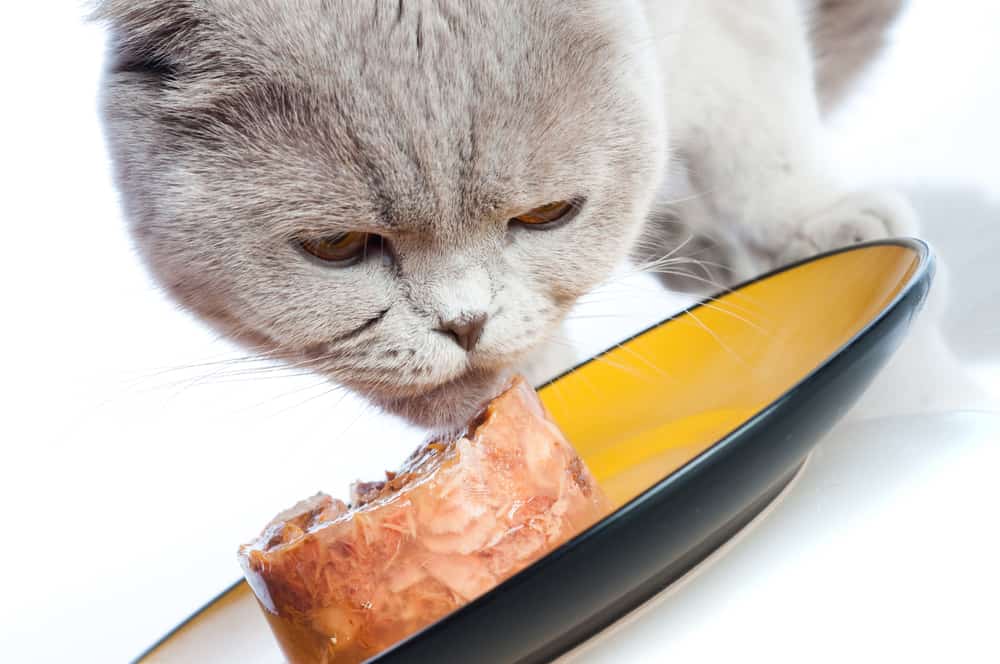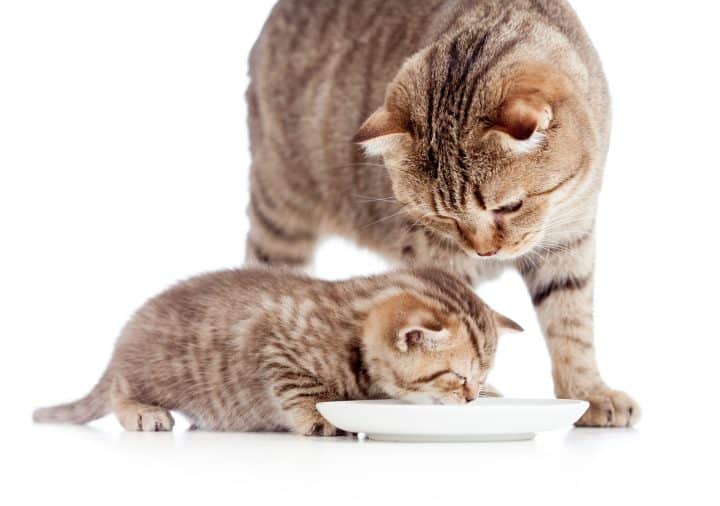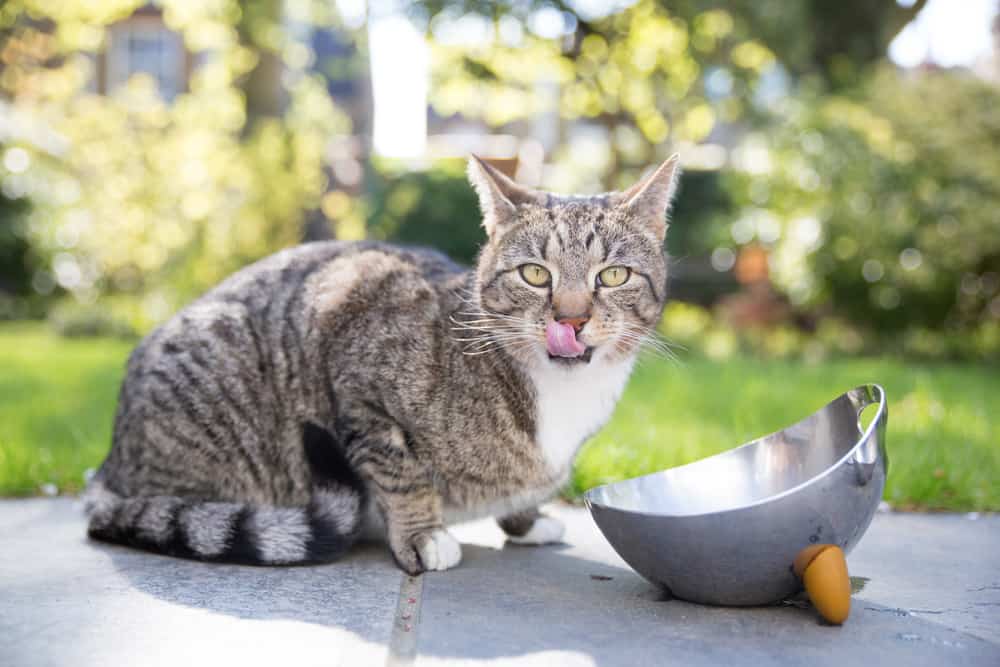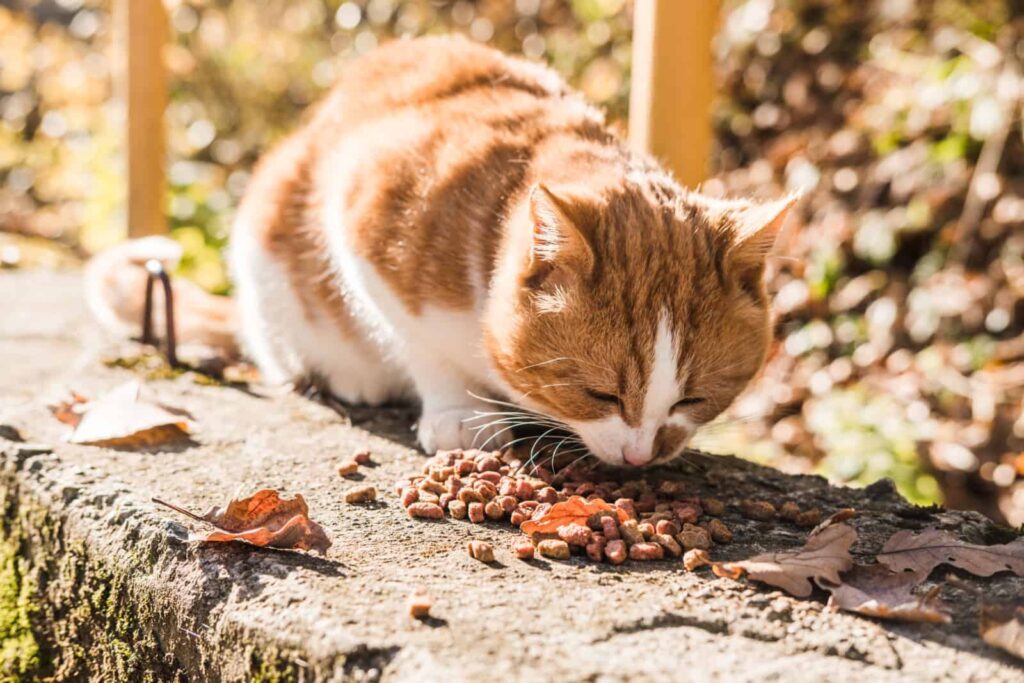In this post:
- What Is The Difference Between Kitten And Cat Food?
- What Happens If My Kitten Keeps Eating My Older Cat’s Food?
- How To Stop My Kitten Form Stealing The Older Cat’s Food?
- Should I Stop My Older Cat From Eating The Kitten’s Food?
- When Can Kittens Eat Adult Food?
- How To Transition From Kitten To Adult Cat Food
- Closing Thoughts
Bringing home a kitten, when you already have a feline companion can be difficult. I’ve lived through the nightmare of having to restrict my new and extremely hungry kitten from the adult cat kibble of my older cat.
As you can imagine the older cat wasn’t too happy, not only he had a territory to maintain, but also a food bowl to protect since the kitten food wasn’t appealing to the new invader.
But what happens if a kitten keeps eating the older cat’s food and is this something you need to worry about?
Kitten food is designed for kittens, as they need more calories, protein, and fats in their diet. So, to have properly developed kittens you shouldn’t let them eat adult cat food until they’re 12 months of age.
If you want to know more about why it’s not optimal for your kitten to keep stealing your older cat’s food, then keep on reading!
We're also going to talk about what you can do to manage the situation!
Let’s go!
What Is The Difference Between Kitten And Cat Food?
Our cats are obligate carnivores, and once they’re off their mother’s milk, they'll need a meat-based diet in order to survive and thrive. Taurine and protein are especially important for their development, while carbohydrates are not a good option since they’re not as easily digestible. As a result, the best cat foods typically have higher protein and lower carbohydrate content.
This rule that applies to the feline species, isn’t the only thing we should pay attention to when it comes to our cat’s diet. It’s also important to understand that each life stage of a cat requires different nutritional attention.
According to Ryan Llera, BSc, DVM “Kitten, adult cat, senior, and geriatric cats are four significant life stages we need to address nutritionally.” He also adds that “diet is extremely important for a growing kitten.”
For this reason, foods that are designed for kittens have the right nutritional value and requirements for a growing tiny ball of fur to develop into a magnificent adult cat, something an adult cat food simply cannot offer.
A Kitten’s Nutritional Needs
So, let’s take a look at what kittens need in order to grow into healthy and fluffy overlords. Firstly, food formulated for kittens is more calorie-dense, to suit a youthful creature that wants to jump around and explore their environment.
You’ll also find a higher amount of protein, fat, and a fatty acid called DHA which is responsible for retinal function and brain development. It’s also important to remember that the growing organism of a kitten needs the right vitamins like calcium and phosphorus to grow strong bones.
Jennifer Larsen, DVM, Ph.D., nutritional consultant, and assistant professor of clinical nutrition at the Veterinary Medical Teaching Hospital at the University of California, Davis, states that “kittens have a higher requirement for protein, amino acids, and minerals, as well as for some vitamins. For example, kittens should get about 30% of their energy from protein.”
Thankfully proper kitten food should tick all those boxes!
What Happens If My Kitten Keeps Eating My Older Cat’s Food?
The growth rate for each kitten can be individual, affected by their breed, genetics their environment, and of course what they eat. Nutrition is something we as cat parents can control and help set the foundations for a healthy cat life.
That’s why adult food shouldn’t be part of a kitten’s diet. Krista Williams, BSc, DVM gives a perfect explanation to this by saying “although the dry matter protein level may be adequate, other nutrients and energy content will not be balanced for optimal growth.”
But even certain brands that sell kitten food might not have the appropriate nutritional value or they're filled with fillers like corn, soy, wheat, or even vegetable. Ryan Llera warns that “advertisements tend to promote taste, color, and shape rather than nutrition, so it is important not be influenced by these ads.”
Feeding your kitty with over the necessary amount of fat, letting them freely graze, or overfeeding them can lead to fast growth, thus increasing your cat’s risks of becoming overweight. Likewise feeding them adult food can lead to an underfed kitten, or once again an overfed one since the somewhat lower protein intake will make them hungrier. It's important to mention that even cat food that's labeled for “all life stages” can't really cover the individual needs of each cat, especially that of a kitten!
If you’re overwhelmed by the task of finding the right kitten food, the best course of action would be contacting your vet and the American Association of Feed Control Officers (AAFCO) can also help you understand what cat food is made of with their list of ingredient definitions for pet food!
How To Stop My Kitten Form Stealing The Older Cat’s Food?
Raising a kitten when you already have an older cat comes with a set of challenges and one of them is the feeding process. This might not concern those few lucky cat owners whose cats stick to their own food bowls, but if your cats are anything like mine then your kitten will need extra attention during mealtimes!
This kitty for example doesn't seem to have much energy for stealing!
But if yours does then I think it's time we take a look at the few steps that can help keep all parties happy and well-fed!
Set A Feeding Schedule
What you definitely need to take into consideration whether you’re feeding an older cat, a kitten, or both, is having a regular mealtime schedule. Living a predictable life with a daily routine might not be your dream but it's the perfect environment for cats. Knowing when they’re going to be fed, helps them feel secure.
“Meals become a cornerstone event of the day around which other activities are added. A feeding routine helps your cat cope when there are changes in the household,” as Ryan Llera, BSc, DVM, explains it perfectly.
Free feeding cats usually doesn't work, and with kittens, it could encourage binge eating, So, make sure you read the label on your package, or better consult your vet for the right portions your kitty will need and break them to at least two meals a day, or more regular but smaller meals if possible, throughout the day.
If a kitten is raised within this concept, it will create an eating habit which is especially important since any changes in your kitten’s appetite can be an early sign of illness you could spot!
Once you’ve established a regular eating schedule for both your older cat and kitten, it’s important to keep it synchronized. This way you’ll be able to keep an eye on both cats and make sure that they both ate their own meals, and most importantly that the little rascal didn’t steal anything from the older cat.
Try Feeding Separately
For some having a schedule is enough to keep the hungry kitten under control, but if the kitten prefers the older cat’s food, then separating them would be the most sensible choice.
When I brought my second cat as a kitten into my home, I had the same problem. I kept finding him neck-deep into the bow with dry kibble. So, I decided to take control of the feeding schedule, which helped me keep an eye on both cats as I fed them, and most importantly, I kept them in separate rooms.
Since my kitten was an extremely fast eater, I had to break the feeding time into multiple meals a day, and I also kept my older cat alone in a separate room with his bowl for much longer. This is a great opportunity for both cats to enjoy their meal without any food stealing, fighting, or stress. In other words, I tried to turn it into a positive day-to-day routine!
As the kitten grew and his eating speed, as well as his need for food, changed, I decided to seize the separation tactic. I still kept an eye on them until the younger cat was old enough to eat the same regular kibble and wet food I was giving to my older feline companion!
Set Up A Feeding Station
This is a great solution for kittens and cats that are a bit on the shy side when it comes to eating, especially for strays that might need to feel completely safe in order to eat. If you’re a creative person you could build a feeding station from wood, or other materials you’re comfortable using.
You could also use your kitten’s carrier as a place where they can eat without the attention of the older cat, and of course, they won’t be able to steal food that isn’t formulated for their needs. Enclosed litterboxes can also work great, where instead of a litterbox, you can place their food and water bowl.
Of course, you’ll still have to make sure that your kitten is eating their own food, but with training based on positive reinforcement, you can make this feeding station their favorite place! Which in turn could help them love kitten food more than they love adult food!
See Also: How To Select A Carrier For Your Cat?
Consider An Automatic Pet Door
A different option that could help keep your cat’s feeding time separate would be an automatic flap door. This option is perfect for those of you who have a spare room, or a door that leads to your garage, providing that it's a safe place for your older cat.
It's better for the automatic cat door to be placed in a room where only your older cat has access, so your kitten won’t be able to steal their food. It’s a great choice for those of you who are away from home most of the day and can’t control your kitten’s actions.
There are several brands that use different technologies to open and shut the cat flap, so let's take a moment to look at my favorites.
Best Overall: SureFlap-Microchip Cat Flap

- Seals the lid to keep food fresh
- Controls portions, reduces pet stress, and prevents food theft
- Compatible with 9, 10, and 15-digit microchip IDs
- Stores up to 32 IDs
- One-button programming for easy setup
- Great for pets on prescription diets
This cat door flap should work perfectly with your cat’s microchip, as it scan's their ID on entry. It works with 9 (Avid Secure), 10 (FDXA), and 15 (FDXB) digit microchip numbers, and if you're unsure of your pet’s microchip number you can simply check in with your veterinarian, pet shelter, or animal rescue. But even if your kitty doesn't have a microchip, don't worry, the company offers programmable collar tags that are sold separately.
If you're worried about how the SureFlap will look, the design is slick and it comes in two colors, white and brown, to match your door perfectly!
Best On A Budget: PetSafe Interior or Exterior Cat Door

- Fits pets up to 25 lb
- Transparent flap for easy acclimation
- Durable plastic for indoor/outdoor use
- 4-way locking system for access control
- U.S. customer support
- Trusted brand since 1998
Our best on a budget pick is manufactured by the well-known brand PetSafe! This cat door can be used both as an exterior and interior door and the sturdy plastic flap promises to last against daily use.
You won't only appreciate the locking system which will give you control over which cat uses it and when, but it's also easy to install. The PetSafe cat door offers instructions but also a template to cut the hole into your door! It's also important to mention that the flap should be a great choice for those of you who have a small and average-sized cat, while it's not suitable for larger breeds like the Maine Coon.
Automatic Pet Feeder
As I mentioned above, “free choice” feeding is not recommended to kittens or cats overall. The risk of overfeeding your cat is too high, and even if you see your cat grazing small amounts throughout the day, you can’t be sure how much they consume while you’re asleep, which is when they’re most active, or when you’re away from home.
According to Ryan Llera, “Regular, routine feeding times allow your cat's body to be prepared for the food it will receive. It is not recommended to keep the bowl filled and allow grazing.”
This is why an automatic cat food feeder can help set schedules and set portions throughout the day and keep both your cats from stealing each other's food.
Best Overall: Cat Mate C500 Automatic Wet Food Feeder

- Program up to 4 separate mealtimes
- Cat Mate Automatic Feeder guarantees timely feeding
- Comes with twin ice packs to maintain food freshness
- Pet-proof and tamper-resistant
- Requires 3xAA batteries (not included)
I found that the Cat Mate C500 automatic wet food feeder really helped me with my sleep since my cats stopped meowing throughout the night or early in the morning, begging to be fed!
Most importantly this automatic feeder can work great for separate feedings! Once the feeding is done, the feeder will close, so even if both cats are around the Cat Mate C500, none of them will manage to steal the next scheduled meal! The twin ice packs that can be placed at the bottom of the feeder will help keep the wet food fresh for up to 24 hours, but it also works perfectly with dry kibble which will of course stay fresh for much longer.
Premium Pick: SureFeed Microchip Pet Feeder

- Seals the lid to keep food fresh
- Controls portions, reduces pet stress, and prevents food theft
- Compatible with 9, 10, and 15-digit microchip IDs
- Stores up to 32 IDs
- One-button programming for easy setup
- Great for pets on prescription diets
Since everyone's living circumstances are different, feeding your kitten and your older cat separately might not be feasible, if that sounds familiar then the SureFeed Microchip Pet Feeder could be a great option for you! I know it's on the pricier side, but the chip recognition technology could truly help your kitten from stealing adult cat food.
I think one of the greatest functions of this feeder is the training mode, which lets your kitty get used to the lid's movement. It's a long-term investment even for when your kitten switches to adult cat food because it's suitable for feeding special food or medication. The only major downside would be the lack of ice packs, and that it doesn't offer multiple meals a day, but it will give you complete control over your kitten's and cat's feeding habits.
What’s important to understand is that all of the above products could work perfectly together. For example, one of the reviewers on the SureFlap automatic pet door attached this door to a large transparent storage box, where their kitty could eat their specially prescribed food without the rest of the cats interfering. Similarly, you could use an automatic microchip feeder inside a feeding station.
With this kind of technology, our cat parent options are limitless!
Should I Stop My Older Cat From Eating The Kitten’s Food?
In some cases you have a kitten craving adult life by plunging himself into the bowl of his older cat mate, but who said the roles couldn’t be reversed?
If you find your older cat nibbling on kitten food, you might see it as something harmless after all both foods look quite similar and food formulated for a young cat usually has more nutritional value. But it’s not the nutritional value that is necessarily problematic, it’s the calories contained in kitten food.
By now we've learned that kittens just like human babies need more vitamins, nutrients, and calories to grow big and strong. When a kitten eats adult food they simply don’t get enough protein and calories to help them reach the optimum growth. On the other hand, if an older cat eats kitten food they receive far more calories than they should, which can lead to weight gain.
Whenever cats or kittens in a multicat household begin to steal food from each other it becomes difficult for cat parents to keep track of how many calories each cat consumes. With kittens and older cats, it can be an even riskier situation. It could be that your kitten doesn’t eat enough, so they become underfed and your older cat eats too much kitten food and they start to gain weight.
It's understandable why an adult cat would eat kitten food since the extra calories and fat make the taste far more appealing. If that's something you've noticed your older fluffball doing then I suggest you talk to your vet and check the above solutions which should work!
When Can Kittens Eat Adult Food?
A kitten’s food journey begins with their mother’s milk, from which they are slowly weaned off at about 8 weeks of age. That’s when our role as cat parents comes in and it’s our turn to take the responsibility of their nutrition into our own hands.
Of course, the transition from milk to solid food can occur earlier, especially when the mother of the kitten isn’t around. In this case, Krista Williams, BSc, DVM, suggests that “kittens should begin eating solid food about 3 1/2 to 4 1/2 weeks of age. Initially, make gruel by mixing milk replacer with a small amount of kitten food; place this mixture in a flat saucer.”
She also adds that “The amount of milk replacer or supplemental moisture should be decreased daily until they are eating the canned or dry food with little or no moisture added (usually by four to six weeks of age).”
The goal during this solid kitten food period is for the kitten to achieve healthy growth, with minimum potential for obesity, and a great function of the immune system! The best way to achieve such excellent nutritional results is by paying a visit to your veterinarian. There they can professionally assess the needs of your cat depending on their life stage.
Cats reach adulthood by the time they’re 1 year old, and that’s when the switch from their kitten and young adult cat food to an adult cat diet has to be made. But simply changing your cat's food isn't enough, finding the right brand and the right category is also important. In some cases, a cat's diet shouldn't be based only on their age, but their breed, longhaired cats for example might need food for shedding, their hunting activity, gender, and overall lifestyle!
How To Transition From Kitten To Adult Cat Food
When the moment comes and your kitty reaches adulthood it's important that the transition from kitten food to adult cat food doesn't happen overnight, instead, a smooth change should give you the best results. Of course, if your kitten was craving adult cat food all this time this process might seem like a piece of cake to you, but it's also possible that over the course of one year your kitten has gotten used to the kitten food and has no recollection and cravings for adult cat food.
This is a great option if you're planning on mixing the two foods.
Days 1-2: Mix ¾ of the normal kitten food with ¼ of the adult cat food.
Days 3-4: Mix half kitten food and half adult cat food in your cat’s bowl.
Days 5-7: Mix ¼ kitten food with ¾ of adult cat food.
Days 8-10: If your cat seems to be happy with the transition you can stop mixing the kitten food into the adult cat food.
Another method of getting your cat to eat adult food would actually rely on avoiding mixing both of them together. Instead, you should introduce a small portion of the adult cat food in a separate bowl, next to the bowl filled with kitten food. Let your cat sniff the new food and recognize the difference.
After a few days, they should start showing interest in the adult cat food. Once they begin to eat it, you can add more adult cat food into the same bowl while reducing the amount of food in the kitten bowl. Once you notice your kitty consistently eating the new food, you can remove the kitten bowl after a week altogether.
During this period, it’s important to keep an eye on how well your cat reacts to the change and the new food. Notice their litterbox routine, and make sure to stay in touch with your veterinarian in case your cat has a bad reaction to the new food.
You might find yourself looking for the perfect adult cat food that won't only suit your kitty, but will also meet their taste preferences, especially if they're picky eaters, but there's always a solution out there, even for the most acquired of tastes!
Closing Thoughts
I think it’s safe to say that each feline companion whether it’s an energetic kitten, a mature adult kitty, or a wise senior cat, all have different nutritional needs.
I’m sure a lot of your fluffy overlords have even more intricate food requirements! But one thing is certain, what we feed our cats during their kittenhood will have a long-lasting effect on their whole life!
Read Next: How Long Can Kittens Go Without Food (Before It’s Alarming)?





